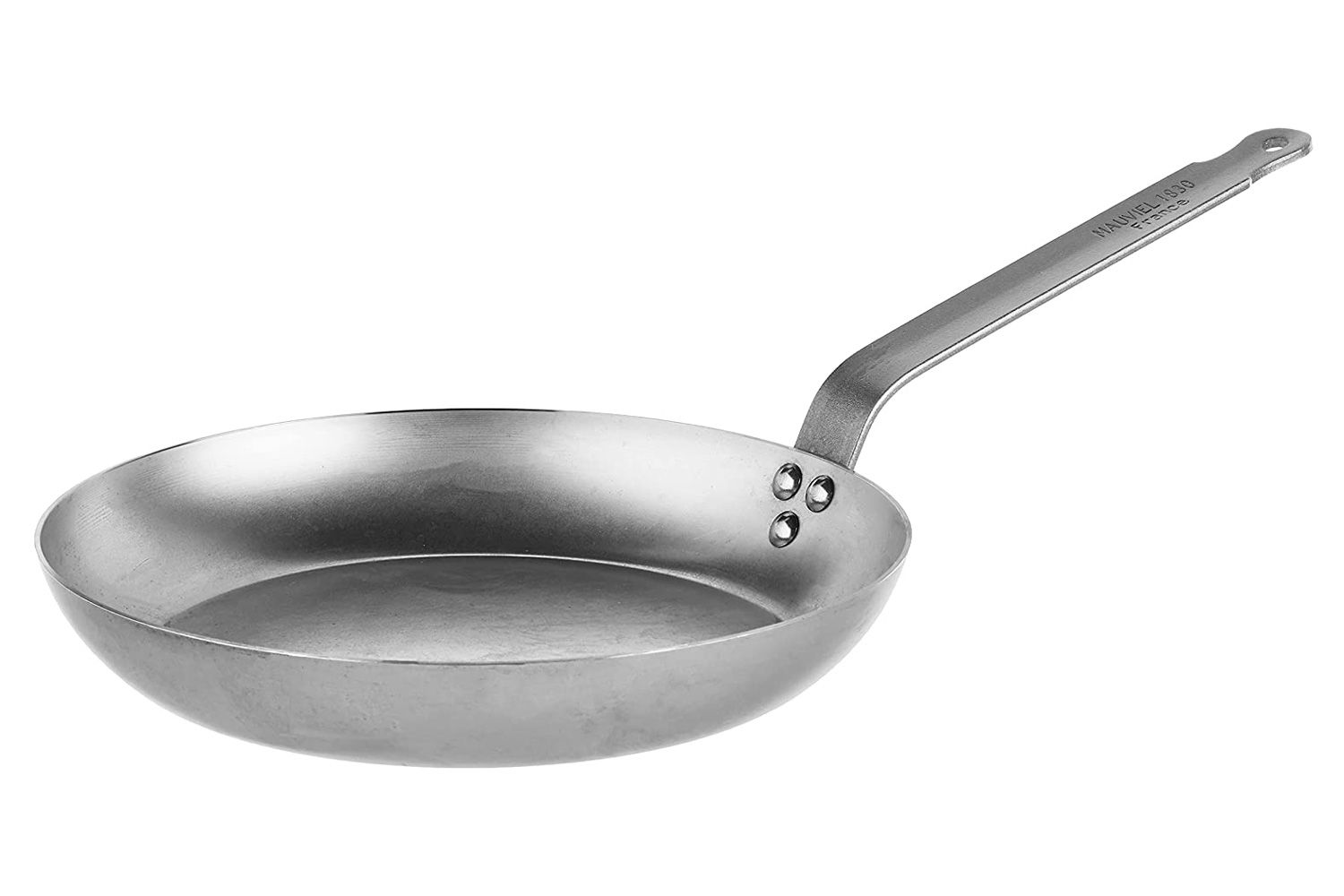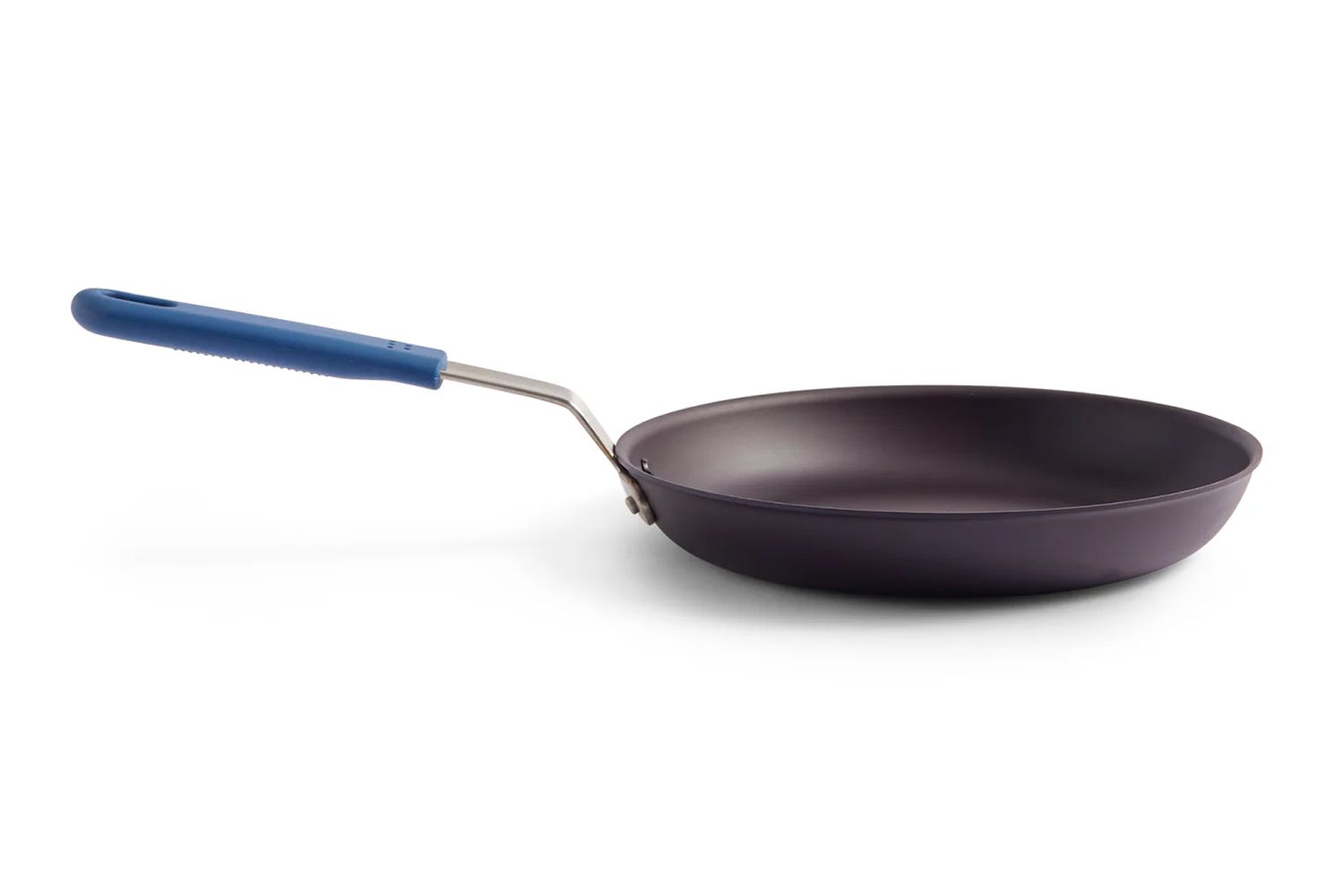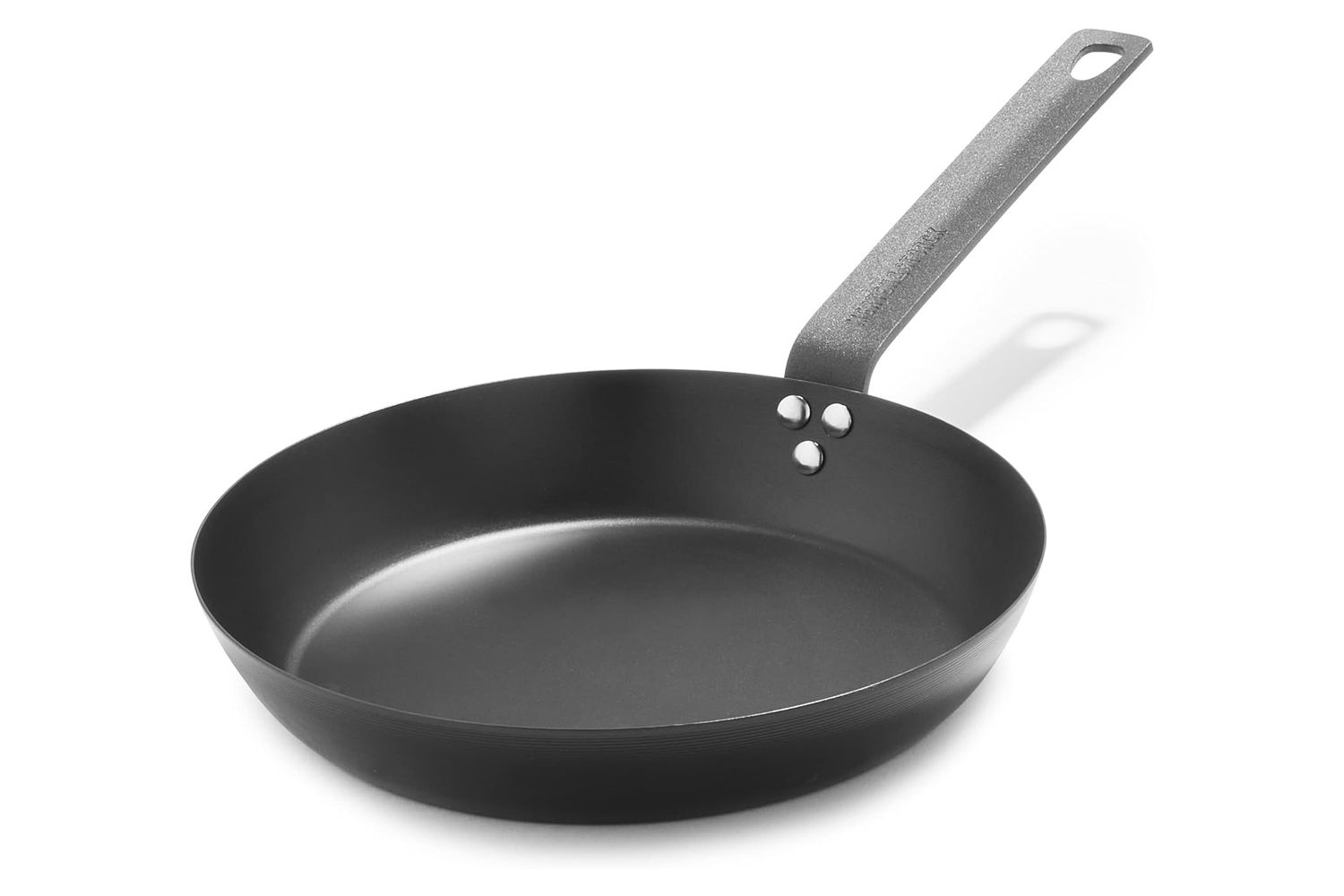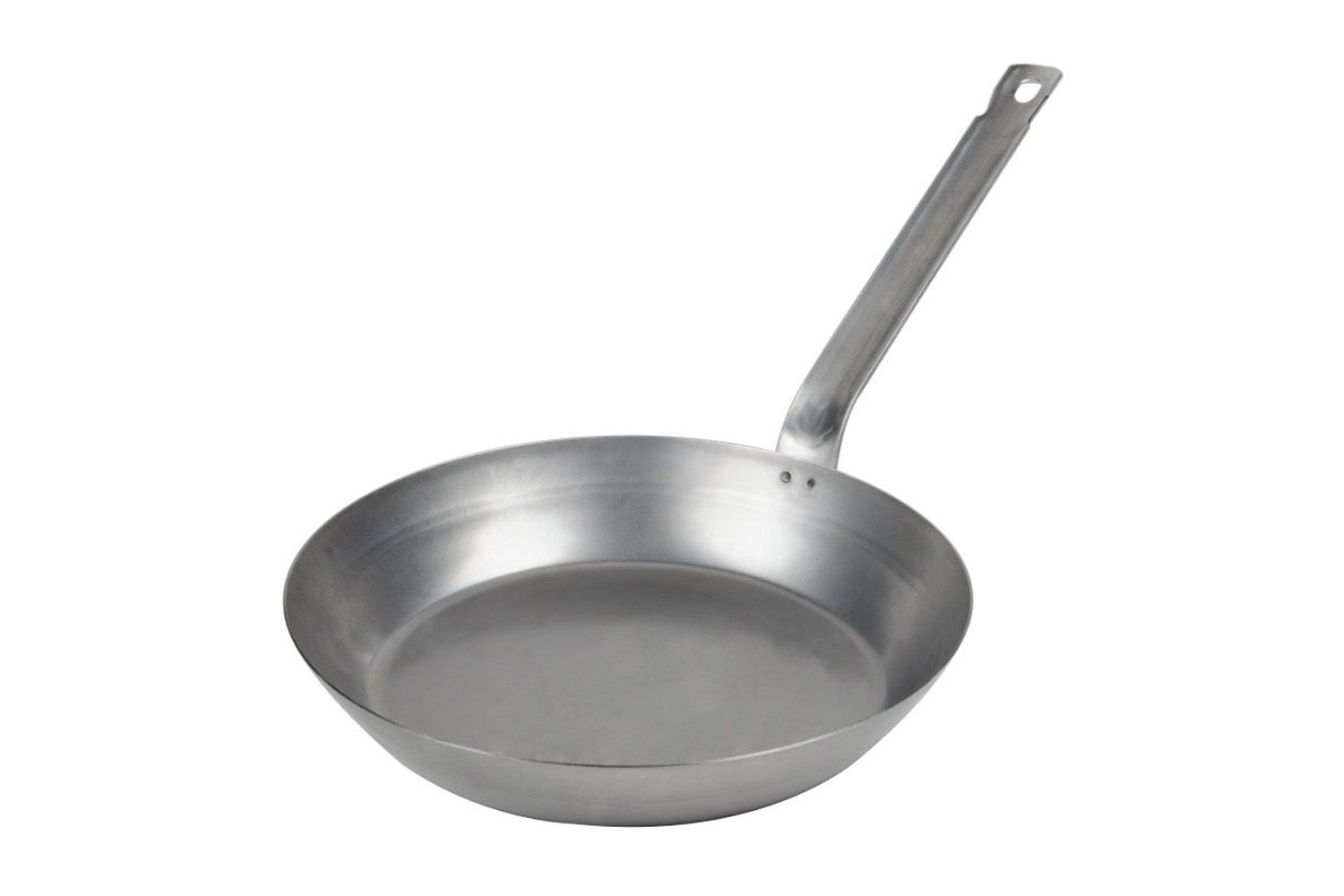How Much Did the Carbon Steel Pans Weigh?
Skillet
Weight
Vollrath 58930 French Style Carbon Steel Fry Pan
2.6 lbs
Smithey Carbon Steel Farmhouse Skillet
5.2 lbs
Made In Blue Carbon Steel Frying Pan
3.2 lbs
Mauviel M’Steel, Carbon, nonstick Fry Pan
3.3 lbs
Matfer Bourgeat Black Carbon Steel Frying Pan
3.11 lbs
OXO Obsidian Pre-Seasoned Carbon Steel
2.6 lbs
Misen Pre-Seasoned Carbon Steel Frying Pan
3.2 lbs
A lightweight pan is also the secret of the bit of culinary magic, where one uses a flick of the wrist to send vegetables careening up the edge of the pan and back onto themselves. If the pan is too heavy, it becomes impossible to sauté with one hand. Some pans were so heavy that they required two hands to lift, which would make tasks like sautéing vegetables and swirling batter pretty tough. In general, we found that pans under three pounds and three ounces were the easiest to lift, even when full of food.
Pre-Seasoned Pans Were a Welcome Convenience
Most pre-seasoned pans were nonstick and ready to use right away.
Serious Eats
A pre-seasoned carbon steel skillet has a layer of seasoning applied by the manufacturer. Almost all of the pre-seasoned pans produced perfect over-easy eggs and delightfully thin crepes that were released without issue (with the exception of the Made In, which probably needed more seasoning despite its “pre-seasoned” claim).
When it came to making the crepes, some of the pre-seasoned pans were almost too nonstick—you need a certain amount of batter to stick to the center so you can swirl the excess batter to the edges of the pan. But while this was a flaw for some pans in crepe testing, we don’t think it’s a dealbreaker overall.
So, while we ultimately still prefer building seasoning up ourselves (as the long-term durability of manufacturers’ coatings is unknown), we do think a pre-seasoned carbon steel skillet, like the OXO, is a worthwhile convenience for those intimidated by seasoning the cookware.
Medium Length Handles with Rounded Edges Were Preferable
Handles with rounded edges were more comfortable to grip than squared-off ones.
Serious Eats
Most carbon steel pans have very similar handles—often an angled, one-inch-wide bar of steel, which you can grip with a kitchen towel or oven mitt when maneuvering the pan. We preferred handles with rounded edges over ones with sharp right angles in terms of comfort. The length can vary, but a good middle ground is between seven and nine inches long. Too short and your hand ends up too close to the flame, but too long and it becomes awkward to handle.
Should You Buy a Carbon Steel or Cast Iron Pan?
Carbon steel pans are lighter and more nonstick than cast iron skillets.
Serious Eats
Can we say both? Both options are durable, have fantastic heat retention, and, with proper seasoning, can be virtually nonstick. The differences are few, but cast iron is heavier. While we have lightweight picks in our cast iron skillet review, the lightest from Lancaster is still a pound heavier than the Mauviel carbon steel pan. As such, carbon steel pans make it easy to toss your food like a chef.
Carbon steel is also a bit more nonstick than most cast iron pans. As Daniel wrote in this piece, “It’s stamped or spun from sheets of metal, not cast like cast iron, which gives it a smooth surface similar to vintage cast iron. This also means that a perfectly seasoned carbon steel pan will have better nonstick properties than a perfectly seasoned modern cast iron pan.” So, in the end, if you want a lighter pan that’s a bit more nonstick once seasoned, a carbon steel pan’s got your back. That said, having one of each isn’t a bad idea.
The Criteria: What to Look for in a Carbon Steel Pan
Serious Eats
First, choose whether you want pre-seasoned or unseasoned carbon steel. The differences between unseasoned carbon steel and pre-seasoned carbon steel are vast. Pre-seasoned pans should be completely nonstick right out of the box, easily releasing sticky eggs and delicate fish. Unseasoned carbon steel skillets are equal once properly seasoned, and we found little difference between cheap pans and more expensive models.
In either style, a lighter weight is better. It heats up faster and is easier to lift. We preferred pans that were less than three pounds and three ounces. We also liked pans with wide, sloping edges that were at least two inches high. Any shorter, and vegetables went flying when we tried to stir or sauté.
Our Favorite Carbon Steel Pans

Credit: Amazon
What we liked: The Mauviel pan has been our favorite carbon steel skillet since we first tested it in 2023. Once properly seasoned, it cooked crepes and eggs without sticking. Its handle stayed relatively cool compared to similarly designed models, and its cooking surface was big enough to cook for two to three people at a time.
What we didn’t like: It was on the heavy side, and the long handle felt a tad awkward when swirling or flipping food in the pan. We noted some sticking during the tarte tatin test, which we suspected was due to the acidity of the onion filling. Eggs stuck at first, too, but that issue went away after we built up the seasoning.
Key Specs
Weight: 3.3 poundsCooking surface diameter: 8.5 inchesPre-seasoned: NoOven-safe: YesMax oven-safe temperature: 680ºFCare: Hand-washInduction compatible: YesWarranty: Lifetime

Credit: Misen
What we liked: Everything—fried eggs, seared chicken, broccoli, and even crepes—slid readily out of this lightweight carbon steel pan. Plus, it came pre-seasoned, so it was ready to cook with right away. Though 10 inches, it had the largest cooking surface of any of our winners (including the 12-inch Vollrath), making it a fantastic option for those without the space to store larger skillets. Though the pan was a little weighty, the silicone-sleeved handle kept it grippy and comfortable to move around with one hand.
What we didn’t like: There were some stubborn bits stuck to the bottom of the pan after we seared chicken, but scrubbing it with coarse salt removed the fond without much effort. Since the silicone cover was only rated to 350°F, we had to remove it before placing the tarte tatin in the oven. The handle wasn’t quite as comfortable without it.
Key Specs
Weight: 3.2 poundsCooking surface diameter: 10.8 inchesPre-seasoned: YesOven-safe: YesMax oven-safe temperature: 500ºF for the pan; 350°F for the handle coverCare: Hand-washInduction compatible: YesWarranty: Lifetime

Credit: Amazon
What we liked: Like our other pre-seasoned winners, this pan was nonstick straight from the box. Its weight felt well-balanced and was easy to manuever one-handed. Compared to the sloped edges of most other carbon steel pans we tested, this one had straighter sides that resembled those of cast iron skillets. It was a good choice for camping and cooks who want a pan that can bake and simmer as well as it can sear and saute. The best part? This model was under $50 at the time of writing.
What we didn’t like: The pan’s flat handle was a bit uncomfortable to hold and got warm during cooking.
Key Specs
Weight: 3 poundsCooking surface diameter: 8 inchesPre-seasoned: YesOven-safe: YesMax oven-safe temperature: 660°FCare: Hand-washInduction compatible: YesWarranty: Lifetime

Credit: Amazon
What we liked: This OXO model was easily the most nonstick pan we’ve ever used (and yes, that includes ceramic- and Teflon-coated pans). At just over two-and-a-half pounds, it was also one of the lightest models we evaluated. It heated evenly and had an ergonomic, removable silicone cover that kept the handle cool.
What we didn’t like: Since it was lighter, it sometimes spun if bumped on glass stovetop burners. Other than that, we struggled to find anything to dislike about this pan.
Key Specs
Weight: 2.6 poundsCooking surface diameter: 8 inchesPre-seasoned: YesOven-safe: YesMax oven-safe temperature: 660ºFCare: Hand-washInduction compatible: YesWarranty: Lifetime

Credit: Vollrath
What we liked: This is a no-frills, super lightweight pan designed for busy restaurant kitchens. It has high, sloped sides that are optimal for tossing ingredients in the pan. Its surface heated quickly and produced beautifully seared chicken, lacy crepes, and flaky tarte tatin.
What we didn’t like: We liked having a kitchen towel nearby to grab the metal handle, as it tended to get warm while we were cooking. Because it had such broad sides, the bottom cooking surface was relatively limited compared to similarly-sized pans.
Key Specs
Weight: 2.6 pounds
Cooking surface diameter: 7.6 inches
Pre-seasoned: No
Oven-safe: Yes
Max oven-safe temperature: 600ºF
Care: Hand-wash
Induction compatible: Yes
Warranty: Warranty does not cover non-commercial foodservice use.
The Competition
Tramontina 10 in Carbon Steel Fry Pan: This pan was tricky to get a spatula into, causing us to tear our crepe during flipping.
Smithey Carbon Steel Farmhouse Skillet: We just could not justify the cost of this skillet, which could neither cook an even crepe nor over-easy eggs without sticking.
Matfer Bourgeat Black Carbon Steel Fry Pan: We had high hopes for this pan, but its weight (almost four pounds) made it unwieldy. Though its cooking surface was quite nonstick, it was on the small side and better suited for one- to two-person households.
Made In Blue Carbon Steel Frying Pan: This pan had high sides that made flipping crepes awkward. Eggs also stuck to the bottom and left marks in the seasoning. Despite coming pre-seasoned, the manufacturer suggests only cooking high-fat foods for the first couple of uses, so this one may have just needed more time to break in.
Lodge Carbon Steel Skillet, Pre-Seasoned: The crepe was pale and unevenly cooked, and it tore when we tried to wiggle a spatula underneath.
De Buyer Mineral B Pro Carbon Steel Fry Pan: This pricey French pan was too heavy for me to lift with one hand comfortably and needed more seasoning time to get a perfectly nonstick surface that could turn out the onion tarte tatin.
Viking Culinary Blue Carbon Steel Nonstick 10” Fry Pan: The pan claims to be pre-seasoned, though the manufacturer requests some seasoning before use anyway. We noticed uneven wear of the patina after just a few uses. It’s more expensive than similarly performing pre-seasoned pans.
Sardel Carbon Steel Skillet: This was one of the only pans where the crepe stuck, despite being seasoned exactly the same as all the others. We also found the handle to be extremely uncomfortable—one of the edges was very sharp. This pan isn’t available anymore.
BelleVie Heavy-duty Carbon Steel Frying Pans Series: The BelleVie was heavy for its small size, and the handle was hard to hold. It’s also not available anymore.
BK Cookware Steel Carbon Steel Fry Pan: This pan performed almost as well as the winners, but the surface was so nonstick that the crepe batter slid all around instead of sticking in the center, resulting in an uneven crepe. The model we tested is no longer for sale.
FAQs
What can you cook in a carbon steel pan?
A carbon steel skillet can be used for everything from sautéed vegetables to seared meat to baked items like cornbread or fruit crumble. They can shallow-fry, cook fish, and roast a whole chicken, too. The only thing you shouldn’t cook in one is long-simmered, acidic sauces, which can eat away at the seasoning.
How do you clean a carbon steel skillet?
Once the seasoning has built up, cleaning a carbon steel skillet can be as easy as wiping it with a paper towel. A little residual fat or oil in the pan is good and will provide a barrier from rust. If more cleanup is needed, some hot water and a scrub brush should do fine, just make sure to thoroughly dry and oil the pan after to avoid rust. (Tip: After cleaning, place the pan on a burner to evaporate any leftover water, then rub the surface with a little oil.)
Why does carbon steel change color?
As you use and season carbon steel, it will change color. This is normal! It’s called patina (what we mentioned above) and helps to prevent the skillet from rusting and created a nonstick-like surface.
Why We’re the Experts
Taylor Murray has been working in food and food media for over 10 years, including in award-winning restaurants. She has tested numerous items for Serious Eats, like tagines and deep-dish pizza pans.
Ashlee Redger is a writer for Serious Eats. She’s reviewed hundreds of cooking products, including portable induction burners and grill pans.
For this review, Taylor tested 15 carbon steel skillets. She used them to cook eggs, crepes, chicken, onion tarte tatin, and more. She also evaluated how easy they were to handle and season.
We recently re-tested our top-performing pans, as well as a few new contenders from Misen, De Buyer, and Viking. After putting them through their paces, Ashlee added the Misen and Merten & Storck to our favorites.


Dining and Cooking